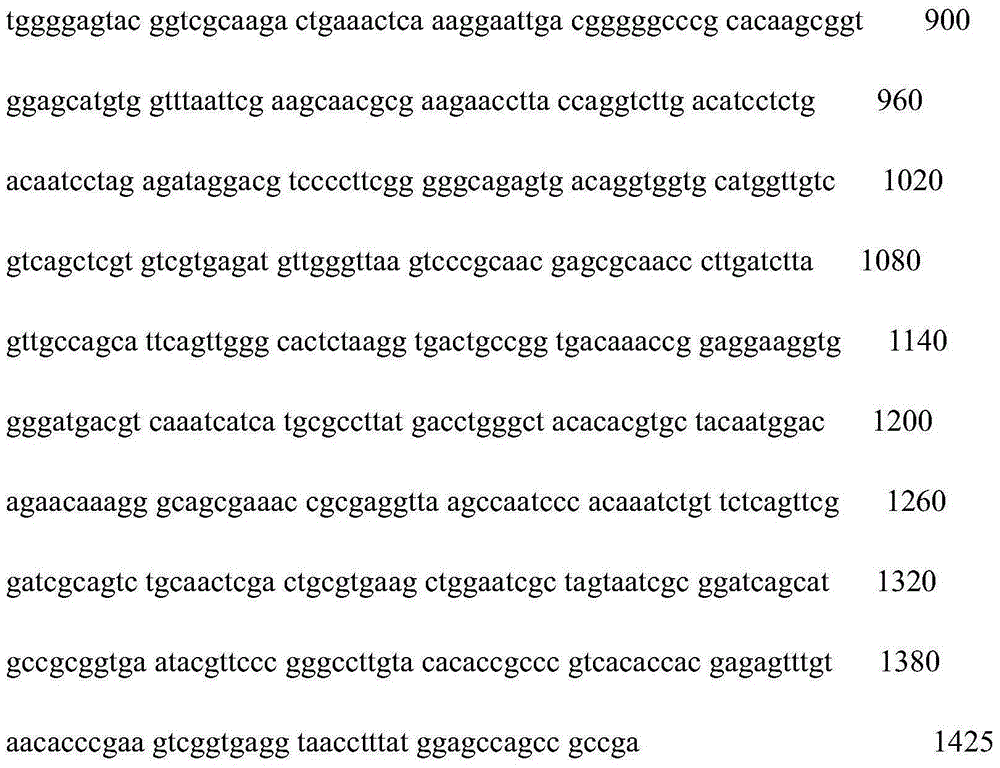Bacillus amyloliquefaciens strain and application thereof
A technology of amylolytic spores and bacilli, applied in the field of agricultural biology, can solve rare problems, achieve low production costs, improve raw material utilization, and reduce the loss of viable bacteria
- Summary
- Abstract
- Description
- Claims
- Application Information
AI Technical Summary
Problems solved by technology
Method used
Image
Examples
Embodiment 1
[0022] Example 1: Screening of Bacillus amyloliquefaciens ZTS-06
[0023] Bacillus amyloliquefaciens ZTS-06 was isolated from cucumber rhizosphere soil. The soil was sampled in Liangzhuang Town, Daiyue District, Tai'an City, Shandong Province, which is the soil of the protected land where cucumbers have been planted continuously for more than 3 years. The specific separation method is as follows: mix the soil sample evenly, weigh 5 g, put it into a conical flask filled with 100 mL enrichment medium and 10 glass beads, and shake and culture at 35°C and 180 rpm for 3 days. Take 1 mL of the enriched culture for 10 -1 ~10 -5 Serial concentration gradient dilution, and then take 10 -3 、10 -4 、10 -5 The three dilutions were spread on the plate containing the selection medium, and cultured upside down at 35°C for 3 days. Single colonies were picked and streaked onto plates containing selection medium, and cultured upside down at 35°C for 3 days. Pick a single colony and transf...
Embodiment 2
[0027] The identification of embodiment 2 Bacillus amyloliquefaciens ZTS-06
[0028] (1) Morphological and physiological and biochemical characteristics
[0029]The morphological characteristics of the ZTS-06 strain are: after culturing on NA medium at 35°C for 48 hours, the colony is round, white to off-white, with a moist, flat, opaque surface. The bacterium is rod-shaped, produces spores, the spores are round, not enlarged, without paraspore crystals, and the Gram stain is positive. The formula of the NA medium is: beef extract 3g, peptone 10g, NaCl 5g, agar 20g, water 1000ml, pH7.0.
[0030] The physiological and biochemical characteristics of the ZTS-06 strain are: positive methyl red test, positive indole test, positive v-p test, positive starch hydrolysis test, positive casein hydrolysis test, positive gelatin liquefaction test, positive D-glucose test, L-Arabia The sugar test was positive, the D-xylose test was positive, the citrate utilization test was positive, the...
Embodiment 3
[0034] Example 3 Degradation Test of Bacillus amyloliquefaciens ZTS-06 to Phenylacrylic Acid, p-Hydroxybenzoic Acid and Cinnamic Acid
[0035] A medium containing phenylacrylic acid was prepared, and its formula was: 1000 mg of phenylacrylic acid, 5 g of peptone, 0.5 g of ammonium sulfate, 0.1 g of magnesium sulfate, 0.2 g of potassium chloride, 0.5 g of sodium chloride, 1000 ml of water, and pH 7.0.
[0036] Prepare a medium containing p-hydroxybenzoic acid, its formula is: p-hydroxybenzoic acid 1000mg, peptone 5g, ammonium sulfate 0.5g, magnesium sulfate 0.1g, potassium chloride 0.2g, sodium chloride 0.5g, water 1000ml, pH7. 0.
[0037] A medium containing cinnamic acid was prepared, and its formula was: 1000 mg cinnamic acid, 5 g peptone, 0.5 g ammonium sulfate, 0.1 g magnesium sulfate, 0.2 g potassium chloride, 0.5 g sodium chloride, 1000 ml water, pH 7.0.
[0038] Bacillus amyloliquefaciens ZTS-06 was transferred into the above three mediums, and cultured at 35° C. and 1...
PUM
 Login to View More
Login to View More Abstract
Description
Claims
Application Information
 Login to View More
Login to View More - R&D Engineer
- R&D Manager
- IP Professional
- Industry Leading Data Capabilities
- Powerful AI technology
- Patent DNA Extraction
Browse by: Latest US Patents, China's latest patents, Technical Efficacy Thesaurus, Application Domain, Technology Topic, Popular Technical Reports.
© 2024 PatSnap. All rights reserved.Legal|Privacy policy|Modern Slavery Act Transparency Statement|Sitemap|About US| Contact US: help@patsnap.com










